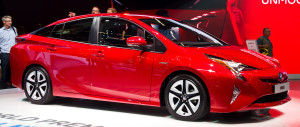 The Prius Prime by Toyota is set to enter the dealership market next month as one of the premier products within the Prius line. This car will be an upgrade of the 2012-2015 plug-in hybrids, with an all-electric capability and a battery of 8.8 kWh. The original plugin in question garnered mixed reviews since its electric range was quite short. While the vehicle was only sold in about fifteen states in the U.S., it was still able to rise as the third best seller worldwide. Toyota established its reputation when it launched the Prius in Japan 1997 and then in the United States in 2000.
The Prius Prime by Toyota is set to enter the dealership market next month as one of the premier products within the Prius line. This car will be an upgrade of the 2012-2015 plug-in hybrids, with an all-electric capability and a battery of 8.8 kWh. The original plugin in question garnered mixed reviews since its electric range was quite short. While the vehicle was only sold in about fifteen states in the U.S., it was still able to rise as the third best seller worldwide. Toyota established its reputation when it launched the Prius in Japan 1997 and then in the United States in 2000.
One of the key merits of the new Prius Prime is its likelihood of having the highest energy efficiency available. Toyota has maximized the Prime’s electrical energy efficiency, which happens to be higher than other all-electric and plug-in hybrids in the U.S. market. It will have a rating of 133 MPGe, which is much higher than that of its predecessor at 95 MPGe. Currently, the highest rated pure electric car is the much anticipated Hyundai Ioniq. The Ioniq electric car has been projected to have 125 MPGe, just a little higher than BMW i3’s 124 MPGe.
Another aspect concerning the new Prius Prime is that its electric range is better than promised. When Toyota confirmed the production of Prime, it said that the expected electric-only range was 22 miles. However, it has been confirmed that the rating given by the EPA for the vehicle is 25 miles. The high range is accounted for by its efficient MPGe powertrain. In the plug-in hybrid sphere, Ford energies have an electric range of 19-20 miles, while Kia Optima and Hyundai Sonata have an average range of 27 miles. This clearly shows that every additional mile matters. Among the gas-electric vehicles, only the Chevrolet Volt outdoes the Prius Prime with a range of 53 miles.
It is exciting that the new Toyota Prius comes with a new design with a refined formula. The new car’s length has been increased by 6.5 inches and its width by 0.6 inches. The interior is also roomier compared to the previous Prius. The Prime’s handling will also be superior, thanks to the new architecture utilized to include two wishbone rear suspensions. Finally, the Prius Prime has a standard starting price. According to Toyota, the price falls within the normal Prius range. Plug-in car buyers can also enjoy a federal tax credit of $4,500, in addition to possible state subsidies.